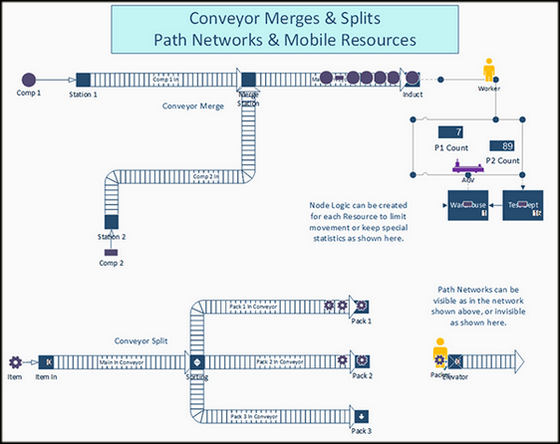Function Comparison of Process Simulator Editions
Process Simulator is available in two editions.
Process Simulator Professional and
Process Simulator Material Handling Edition
Process Simulator Professional allows you to build rich models. With the help of the Output Viewer, Microsoft Excel or Minitab you can easily analyze the simulation results. Based on the power user functions complex models can be created generically and maintainability of the model logic can be increased. This helps to increase your productivity.
With Process Simulator Professional your company has an effective simulation tool at its disposal. It accelerates and improves the results of your continuous improvement programs as well as your Lean-Six-Sigma initiatives.
With the Process Simulator Material Handling Edition you can now model the material flow in detail in your Process Simulator models. Along with the drawing environment being scaled, you now will have access to Stations, Conveyors and Path Networks.
These well-thought-out functions for your success can be found in the following tables.
Process Simulator Evaluation
GBU Live eSeminar
Process Simulator Tutorials
Description and differentiation of the available functions
Feature
Description
Professional
Material Handling
Microsoft Visio Plug-In (32bit and 64bit) for Modelling
Convert existing diagrams and build new simulation models within the familiar and easy-to-use Visio application.


Fast Model Making & Script Language
Parameterize predefined model elements to graphically design your simulation models - without programming. If required, a powerful script language is available to implement user-specific logic.


Process Flows and Value Streams
Use any notation to model your processes. Process Simulator provides its own shape library for modeling value streams.


ProModel Simulation Engine
Harnesses the predictive power of the ProModel simulation engine to run scenarios and produce results for what-if analyses.


Scenario Management with the Output Viewer
Allows comparison and analysis of simulation results of different scenarios from the same model or from different models in the Output Viewer - a graphical results editor.


Bidirectional Interfaces to Microsoft Excel
Separate model and data. Use Microsoft Excel to validate your models (Build Time) and as a database to import simulation data and write results (Run Time).


Product Mix Simulation
Differentiation of process rules for different products: processing times, resource allocations, routings and user-defined behavior.


Simulate Employees and Transports
Modelling of static resources - employees and means of transport represent restrictions in the process flow.


Modelling AGVs and Material Handling
Use driverless transport systems as well as material flow and logistics systems in your simulation models.

Mobile Resources on Path Networks
Definition of the running or travel paths including speed and acceleration as well as user-defined behavior.

Conveyor Systems: Belt & Roller Conveyors
Differentiation of belt and roller conveyors with definition of length, speed and user-defined behavior of the belt segments. At stations the material flow branches out or is merged.

Description of the common functions of Process Simulator Professional and Material Handling
Feature
Description
Professional
Material Handling
Share Models with ProModel and MedModel
Models created in Process Simulator can be opened and expanded in ProModel or MedModel.


Animation
The Visio diagrams are graphically animated during the simulation and display the progress and current state of the simulated flows over time.


Convert Existing Visio Diagrams to a Model
Convert existing Microsoft Visio diagrams to simulation models.


User-Defined Distributions
Defining custom distribution features.


Basic Logic Builder
Enables creation of the model logic of activities, resources and routings through guided dialogues.


Storage and Supermarket Modeling
Model Pull- or Kanban-systems with the help of supermarkets.


Hierarchical Modeling with Sub-Processes
Use hierarchical models.


Resource Pool Definition
Define group work models.


Custom Results Analysis with Excel
Create custom reports in Microsoft Excel.


Six Sigma Analysis with Minitab
Use Minitab for Six Sigma analysis of your results.


Model Adjustments in Excel
Use Microsoft Excel to customize your simulation models.


Basic Subroutine Functionality
Use subroutines for commonly used model code in the model.


Utilizes Power of Visio Data Graphics
Visualize the simulation results directly in the shapes of your modeled processes within the Visio drawing.


Initialize Arrivals from Excel
Read in your arrivals from Microsoft Excel.


2-Dimensional Arrays (tables)
Large amounts of data can be used in an Excel spreadsheet-like structure (matrix) in your models.


Import/Export of data from/to Excel
Allows to accept the values from an Excel spreadsheet at the start of a simulation and to write at the end of a simulation.


Advanced Logic Builder
Use advanced statements and functions in the logic wizard in model logic.


Subroutines with Transfer Parameters and Return Values
A subroutine can be started with transfer parameters and returns a calculated return value.


Complex Expressions in Property Fields
Use a subroutine with a return value in a property field instead of a numeric value.


Free Form Logic
In another window, the logic code can be written without the use of the logic wizard.


Intellisense for Fast Logic Creation
Start writing your model code and Intellisense completes it automatically.


Syntax Guide for Quick Logic Help
Clear selection from the options of your command words.


Multi-Destination Flexible Routing
Use Flexible Routing to identify alternative targets in the model and not to have to draw them graphically.










